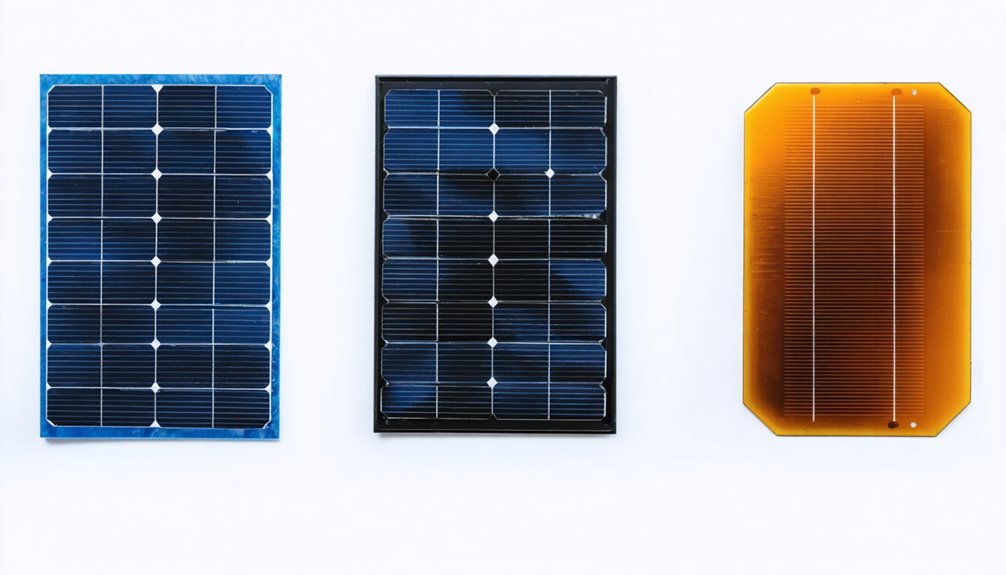You’re considering solar panels for your home or business, and efficiency matters most for maximizing energy output. Monocrystalline, polycrystalline, and thin-film options each offer unique benefits, but their efficiency levels vary widely. You might wonder which one delivers the best performance in limited space or on a budget. Let’s break down the differences to help you decide wisely.
Key Takeaways
- Monocrystalline panels offer the highest efficiency, ranging from 15% to 24%.
- Polycrystalline panels have efficiencies of 13% to 16%, making them more affordable.
- Thin-film panels provide efficiencies from 7% to 20%, excelling in low-light conditions.
- Monocrystalline outperforms others in high temperatures with better power output per area.
- Efficiency choice depends on budget, space, and application needs for optimal selection.
Monocrystalline Solar Panels

If you’re considering solar options, you’ll find monocrystalline panels stand out with their single, continuous silicon crystal structure, delivering efficiency rates from 15% to 24%—and some hitting 24.3%.
You’ll appreciate their sleek black appearance, which blends seamlessly into modern setups, while they deliver higher power output per square meter, with ratings from 250W to over 450W.
You get superior performance in high-temperature environments, as these panels maintain efficiency better and suffer lower losses. They boast a longer lifespan, often exceeding 25 years, with minimal degradation rates that boost your long-term energy yield and return on investment.
When selecting a solar panel supplier, prioritize those offering advanced N-type monocrystalline cells, like the Longi Hi-MO X10 series, projected to reach 24.7% efficiency by 2025. You’ll harness cutting-edge technology for peak solar results. To ensure top reliability and performance in your home installation, focus on choosing the best Tier-1 solar panels from leading manufacturers.
Polycrystalline Solar Panels
Polycrystalline solar panels offer a cost-effective alternative, crafted from multiple silicon crystals that deliver efficiency rates of 13% to 16%.
You’ll appreciate how manufacturers produce them more affordably than monocrystalline panels, thanks to a simpler process that cuts down on waste. This makes them a smart choice if you’re budget-conscious and eyeing solar for your home.
You can count on their durability; they typically last 25 years or more, with just about 1% power loss each year.
However, you’ll notice their efficiency lags behind monocrystalline options, which limits performance in high-temperature spots—though the efficiency drop in heat isn’t quite as steep as with monocrystalline panels.
As of 2023, you’ll see polycrystalline panels holding strong popularity for residential setups.
They strike a great balance of cost, solid performance, and easy availability, even as newer tech pushes boundaries.
Thin-Film Solar Panels
Thin-film solar panels deliver a flexible and lightweight alternative, with efficiencies spanning 7% to 20%—cadmium telluride (CdTe) versions dominate the market, reaching up to 17.3%.
You appreciate their portability; they’re perfect for on-the-go uses or embedding in building elements like solar blinds. You’ll find their production costs lower than crystalline silicon panels because they require fewer materials, which boosts mass manufacturing efficiency.
Though you notice their overall efficiency lags behind crystalline types, you benefit from their superior temperature coefficients—they handle heat well without much performance drop. Plus, you get better output in dim light, making them reliable in varied conditions.
However, you must consider recycling challenges; hazardous cadmium in some panels demands better disposal methods to enhance sustainability.
Conclusion
You’ve compared monocrystalline panels’ high 15-24% efficiency for space-saving power, polycrystalline’s budget-friendly 13-16% output, and thin-film’s versatile 7-20% flexibility. Now, choose what fits your needs—if you’re tight on space, go monocrystalline; for affordability, pick polycrystalline; or opt for thin-film if you want lightweight adaptability. Whichever you select, you’re stepping toward sustainable energy that powers your world efficiently.


